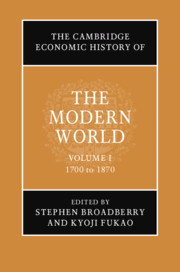Book contents
- The Cambridge Economic History of the Modern World
- The Cambridge Economic History of the Modern World
- The Cambridge Economic History of the Modern World
- Copyright page
- Contents
- Figures
- Tables
- Contributors to Volume I
- Preface and Acknowledgements
- Introduction to Volume I
- Part I Regional Developments
- 1 Britain, the Industrial Revolution, and Modern Economic Growth
- 2 Continental Europe
- 3 Tokugawa Japan and the Foundations of Modern Economic Growth in Asia
- 4 China: The Start of the Great Divergence
- 5 From the Mughals to the Raj: India 1700–1858
- 6 Sustainable Development in South East Asia
- 7 The Ottoman Empire, 1700–1870
- 8 The Economic History of North America, 1700–1870
- 9 Latin America: 1700–1870
- 10 Africa: Slavery and the World Economy, 1700–1870
- 11 Australia: Geography and Institutions
- Part II Factors Governing Differential Outcomes in the Global Economy
- Index
- References
2 - Continental Europe
from Part I - Regional Developments
Published online by Cambridge University Press: 03 June 2021
- The Cambridge Economic History of the Modern World
- The Cambridge Economic History of the Modern World
- The Cambridge Economic History of the Modern World
- Copyright page
- Contents
- Figures
- Tables
- Contributors to Volume I
- Preface and Acknowledgements
- Introduction to Volume I
- Part I Regional Developments
- 1 Britain, the Industrial Revolution, and Modern Economic Growth
- 2 Continental Europe
- 3 Tokugawa Japan and the Foundations of Modern Economic Growth in Asia
- 4 China: The Start of the Great Divergence
- 5 From the Mughals to the Raj: India 1700–1858
- 6 Sustainable Development in South East Asia
- 7 The Ottoman Empire, 1700–1870
- 8 The Economic History of North America, 1700–1870
- 9 Latin America: 1700–1870
- 10 Africa: Slavery and the World Economy, 1700–1870
- 11 Australia: Geography and Institutions
- Part II Factors Governing Differential Outcomes in the Global Economy
- Index
- References
Summary
This chapter reviews dramatic changes in the European economy between 1700 and 1870. The period saw a rapid population increase, slow structural transformation away from agriculture, and a gradual spread of modern economic growth across the continent. We discuss the proximate causes of these phenomena – namely, technical progress and the adaptation of English technology, growing integration of markets and upsurge of trade, and institutional modernization and the birth of the modern state.
- Type
- Chapter
- Information
- The Cambridge Economic History of the Modern World , pp. 45 - 66Publisher: Cambridge University PressPrint publication year: 2021

